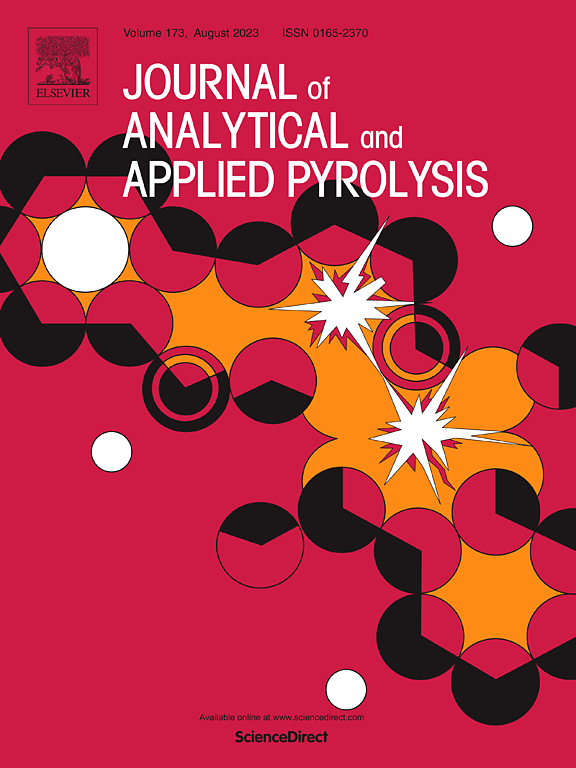厌氧消化作物废弃物热解产物质量变化:厌氧消化和不同热解条件下增加无机物的影响
IF 5.8
2区 化学
Q1 CHEMISTRY, ANALYTICAL
引用次数: 0
摘要
关于厌氧消化(AD)过程的各种情况,由于剩余材料的数量,一直是研究的主题,以增加循环并产生除沼气外的更多高价值产品。源于农作物废弃物的消化物首先被用于慢速、快速和微波热解,作为ad后的附加处理,以产生更多的绿色产品。评估了另一种方案,即直接将原始作物废物(AD前作物)进行热解,而不首先将其送入AD系统,以评估和区分该作物废物和消化物之间的热解产物。约95 wt%的预ad主要由生物聚合物组成:16 wt%的纤维素,36 wt%的半纤维素,15 wt%的木质素,29 wt%的淀粉,只有4 wt%的灰分。从同一作物废弃物AD系统中收集的作物消化液也进行了更深入的分析。这一分析表明,ad前的变化主要是淀粉和半纤维素的组成,以及灰分含量几乎增加了一倍。在355-530 °C下缓慢热解的ad前作物得到了50% wt%的生物油和大量的原生纤维素衍生物。相比之下,同样的ad前作物,在500和700 W的功率输入下,经过5 min的微波热解,产生的生物油在17 wt%到26 wt%之间,其特点是乙酸浓度高,糖含量少。此外,研究人员还对预ad和消化物热解产生的生物炭作为可持续的CO2吸附剂的能力进行了评估,并对其在减少CO2排放方面的潜在应用进行了评估。ad前作物经微波和慢速热解得到的生物炭的比表面积为170 ~ 227 m2/g。虽然消化物来自相同的ad前作物,但使用慢速热解获得的生物炭具有较小的表面积,在400 °C左右时,其值在80至130 m2/g之间,在500 °C时平均为175 m2/g;快速热解145 ~ 185 m2/g,微波热解71 ~ 115 m2/g。AD废弃物显示出相当大的热化学转化前景;然而,AD过程中灰分含量的改变阻碍了高纤维素和木质素作物消化物热解产物质量的提高。本文章由计算机程序翻译,如有差异,请以英文原文为准。
Quality variation of pyrolytic products from anaerobic digestion crop waste: Influence of increasing inorganics through anaerobic digestion and different pyrolysis conditions
A variety of scenarios concerning the anaerobic digestion (AD) process, due to the amount of material remaining, have been the subject of studies to increase circularity and to generate further high-value products in addition to biogas. Digestate, originated from crop waste, was first utilized in slow, fast and microwave pyrolysis as an additional treatment post-AD for more green product generation. An alternative scenario was assessed whereby the original crop waste (the pre-AD crop) was pyrolyzed directly, without being first fed into an AD system, to evaluate and differentiate the pyrolytic products between this crop waste and the digestate. Around 95 wt% of pre-AD consists of mainly biopolymers: 16 wt% cellulose, 36 wt% hemicellulose, 15 wt% lignin, 29 wt% starch, and only 4 wt% of ash. Crop digestate, collected from the same crop waste AD system, was also analyzed more thoroughly. This analysis revealed that pre-AD changes primarily in the composition of starch and some hemicellulose, as well as an increase in ash content by almost double the amount. The pre-AD crop treated with slow pyrolysis at 355–530 °C yielded 50 wt% of bio-oil with a large amount of primary holocellulose derivatives. In contrast, the same pre-AD crop subjected to microwave pyrolysis for 5 min at a power input of 500 and 700 W generated between 17 wt% and around 26 wt% of bio-oil, characterized by a high acetic acid concentration and a small amount of sugars. Furthermore, biochars derived from the pyrolysis of pre-AD and digestate were evaluated for their capacity as sustainable agents for CO2 adsorption for potential applications in reducing CO2 emissions. The surface area of biochars derived from the pre-AD crop subjected to microwave and slow pyrolysis showed values ranging from 170 to 227 m2/g. Although the digestate is from the same pre-AD crop, the biochars derived using slow pyrolysis had less surface area, with values between 80 and 130 m2/g at around 400 °C, and an average of 175 m2/g at 500 °C; with fast pyrolysis 145–185 m2/g, and a range of 71–115 m2/g with microwave pyrolysis. The AD waste exhibited considerable promise for thermochemical conversion; however, the modification of ash content during the AD process hindered the enhancement of quality in pyrolytic products derived from high-cellulose and -lignin crop digestate.
求助全文
通过发布文献求助,成功后即可免费获取论文全文。
去求助
来源期刊
CiteScore
9.10
自引率
11.70%
发文量
340
审稿时长
44 days
期刊介绍:
The Journal of Analytical and Applied Pyrolysis (JAAP) is devoted to the publication of papers dealing with innovative applications of pyrolysis processes, the characterization of products related to pyrolysis reactions, and investigations of reaction mechanism. To be considered by JAAP, a manuscript should present significant progress in these topics. The novelty must be satisfactorily argued in the cover letter. A manuscript with a cover letter to the editor not addressing the novelty is likely to be rejected without review.

 求助内容:
求助内容: 应助结果提醒方式:
应助结果提醒方式:


